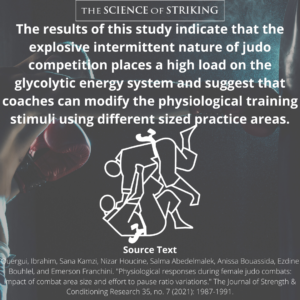The environment within which an athletic event takes place can influence the physiological and psychological response of competitors, therefore influencing performance. Changes in competition area may force technical and tactical changes, therefore increasing or decreasing output and effort, and may also change perceived pressure. 



This study assessed the rate of perceived exertion (RPE), heart rate and blood lactate response of 20 elite female judoka to a 4m sparring bout on different mat sizes (4x4m, 6x6m, 8x8m), as well as with 3 different work:rest ratios (Self-selected (free), 2:1, 3:1). The free condition was hypothesised to result in a lower work:rest ratio, however this was not confirmed during the study. The combination of these different conditions resulted in 9 different test conditions, which were all separated by at least 48 hours.
All physiological and psychological responses were increased in the free work:rest condition compared 3:1 & 2:1 conditions and in the 4x4m area compared to the 6×6 and 8×8 areas.
The results of this study indicate that the explosive intermittent nature of judo competition places a high load on the glycolytic energy system and suggest that coaches can modify the physiological training stimuli using different sized practice areas.
#thescienceofstriking #judo #grappling #lactate #glycolytic #olympicjudo
Ouergui, Ibrahim, Sana Kamzi, Nizar Houcine, Salma Abedelmalek, Anissa Bouassida, Ezdine Bouhlel, and Emerson Franchini. “Physiological responses during female judo combats: impact of combat area size and effort to pause ratio variations.” The Journal of Strength & Conditioning Research 35, no. 7 (2021): 1987-1991.